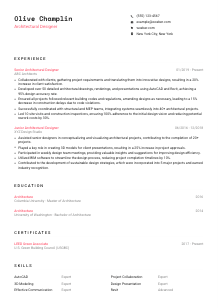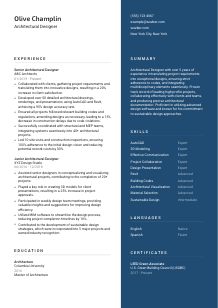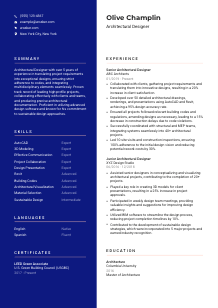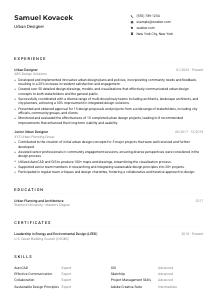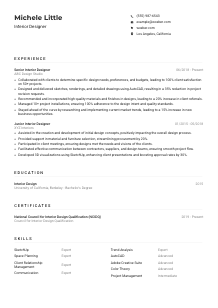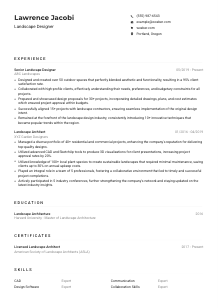Architectural Designer Resume Example
Blueprints to success, but your resume doesn't stand out? Draft a closer look at this Architectural Designer resume example, sketched with Wozber free resume builder. It demonstrates how you can sculpt your design acumen to meet job specifics, ensuring your career rises as stunningly as your structures.

How to write an Architectural Designer resume?
Embarking on your Architectural Designer journey is both thrilling and daunting. The key to unlocking opportunities in this field lies in a well-crafted resume. It's your blueprint for success, distinguishing you in a sea of applicants. With the aid of Wozber's free resume builder, this guide is tailored to help you sculpt an ATS-compliant resume that resonates with your dream job. Let's mold your resume into a work of art that mirrors the precision and creativity of your architectural projects!
Personal Details
Your personal details are the foundation of your resume. In crafting a resume for an Architectural Designer, attention to detail begins here. With these steps, you'll ensure your introduction sets the right tone and aligns perfectly with the profession's expectations.
1. Define Your Professional Identity
Start by making your name memorable. Choose a font that's clean and professional. Your job title, "Architectural Designer," directly beneath your name, primes the hiring manager's expectations and aligns with the job you're seeking.
2. Make Contact Info Crystal Clear
Provide a straightforward phone number and a professional email. A format like firstname.lastname@email.com keeps things tidy and approachable. Confirm these details meticulously to avoid any missed connections.
3. Confirm Your Locale
Being in "New York City, New York" as required by the job description means you meet a fundamental criterion. Mention your city and state upfront to reassure employers there's no need for relocation, which is a plus for both parties.
4. Harness the Power of Professional Networks
If you have a LinkedIn profile or a digital portfolio showcasing your projects, include it. Ensure it accurately reflects your resume. This provides a richer picture of your professional journey and design philosophy.
5. Essential Details Only
Keep it professional by omitting personal details like age or marital status which are irrelevant to your ability as an Architectural Designer. Focus on what matters to the role and the value you bring.
Takeaway
The Personal Details section is where your journey on paper begins. Make it compelling, concise, and tailored to the Architectural Designer role. This is your initial handshake with the hiring manager, make it count!





Experience
Your experience shapes the core of your resume, indicating the landscapes you've navigated in your architectural journey. Here's how to sculpt this crucial section to showcase a trajectory that aligns with the specific requirements of an Architectural Designer position.
- Collaborated with clients, gathering project requirements and translating them into innovative designs, resulting in a 20% increase in client satisfaction.
- Developed over 50 detailed architectural drawings, renderings, and presentations using AutoCAD and Revit, achieving a 95% design accuracy rate.
- Ensured all projects followed relevant building codes and regulations, amending designs as necessary, leading to a 15% decrease in construction delays due to code violations.
- Successfully coordinated with structural and MEP teams, integrating systems seamlessly into 40+ architectural projects.
- Led 10 site visits and construction inspections, ensuring 100% adherence to the initial design vision and reducing potential rework costs by 30%.
- Assisted senior designers in conceptualizing and visualizing architectural projects, contributing to the completion of 20+ projects.
- Played a key role in creating 3D models for client presentations, resulting in a 25% increase in project approvals.
- Participated in weekly design team meetings, providing valuable insights and suggestions for improving design efficiency.
- Utilized BIM software to streamline the design process, reducing project completion timelines by 10%.
- Contributed to the development of sustainable design strategies, which were incorporated into 5 major projects and earned industry recognition.
1. Distill the Job Requirements
Carefully dissect the job listing. Note the emphasis on "proficiency in AutoCAD, Revit" and the requirement for "collaboration with clients." Each requirement you meet is a pillar in the architecture of your resume.
2. Frame Your Narrative
List your roles chronologically, highlighting your most relevant and recent experiences at companies like ABC Architects or XYZ Design Studio. Clearly state your position, company name, and tenure to build a timeline of your growing expertise.
3. Highlight Your Achievements
For each position, draft accomplishment statements that resonate with the job description. Mention how you "collaborated with clients" or "developed over 50 detailed architectural drawings." Quantify your achievements to give them weight.
4. Quantify Your Impact
Specific figures, like a "20% increase in client satisfaction" or "reducing project completion timelines by 10%," make your contributions tangible. They demonstrate the measurable impact you've had, a testament to your skills and dedication.
5. Stay on Target
Resist the urge to list every project or task you've ever tackled. Focus on those that align best with the job description, like coordination with MEP teams or ensuring adherence to building codes. Precision here reflects your architectural mindset.
Takeaway
The Experience section is where your professional story unfolds. Each bullet point should build upon the next, creating a narrative of growth, skills, and success. Like a well-designed building, ensure each part contributes to a stronger whole.
Education
In the realm of Architectural Design, your educational qualifications lay the groundwork of your expertise. Illustrating your academic background with precision ensures you meet the foundational criteria of your desired role.
1. Align With Educational Prerequisites
The job requires a "Bachelor's or Master's degree in Architecture." Directly match this by listing your degree(s) from institutions like Columbia University, ensuring they mirror the job requirements exactly.
2. Simplicity in Structure
Organize your educational qualifications clearly. Start with the degree, followed by the field of study, then the institution, and the year of graduation. This simple structure is easily navigable for hiring managers.
3. Customize to Complement
Your Master of Architecture and Bachelor of Architecture degrees are directly in line with job expectations. If you have specialized in areas particularly relevant to the job, like sustainable design, highlight these for added impact.
4. Academic Accolades
Include honors, relevant coursework, or thesis projects if they exemplify skills or knowledge essential to an Architectural Designer. Especially for recent graduates, these details can compensate for less professional experience.
5. Beyond the Classroom
For roles as dynamic as Architectural Designer, any extracurricular involvement that showcases leadership, teamwork, or creative problem-solving can be pertinent. Highlight these experiences if they align with the role's demands.
Takeaway
Your Education section validates your technical and theoretical foundation in architecture. Crafted wisely, it not only demonstrates your qualification but also your potential to grow into and beyond the role you aspire for.
Certificates
In architecture, certification can be a concrete affirmation of your technical proficiency and commitment to professional development. Let's lay out how to integrate certificates into your resume, making it evident that you're up-to-date with industry standards.
1. Connect with the Job's Core
While not explicitly mentioned, certifications like the LEED Green Associate validate your dedication to sustainable design, resonating with the industry's shift towards greener practices. Highlight those that are directly tied to key responsibilities or advancements in the field.
2. Selection Is Key
Prioritize certifications that directly enhance your candidacy for the Architectural Designer role. Your LEED Green Associate certification, for instance, underscores a commitment to sustainability that's highly valued in the field.
3. Present with Precision
List each certification clearly, with the issuing body (eg. U.S. Green Building Council) and the date obtained or renewed. Dates denote recency and relevance, reassuring employers of your continued proficiency.
4. Continuous Learning
The architectural field constantly evolves, and so should you. Regularly update your certifications and seek new ones that align with your career goals and the industry's forward momentum.
Takeaway
The Certificates section is a testament to your professional growth and skill refinement. Carefully selected and up-to-date certs not only complement your experience and education but also underscore your commitment to excellence in Architectural Design.
Skills
In the domain of Architectural Design, your skills are the tools of your trade. The Skills section is where you showcase your proficiency in technology, methodologies, and interpersonal abilities. Let's ensure your toolbox is both impressive and aligned with the job specs.
1. Harvest From the Job Listing
Identify both the explicit and implicit skills desired in the job description. Skills like "proficiency in AutoCAD and Revit," "strong understanding of building materials," and "effective communication" are directly applicable. Make sure these are prominently listed in your resume.
2. Highlight Pertinent Proficiencies
Focus on skills that directly speak to the requirements: from your expert-level command of AutoCAD to your advanced know-how in Revit. Mix in soft skills like "effective communication" to present a well-rounded candidacy.
3. Organize for Impact
Group your skills logically, starting with those most critical to the role – architectural software expertise, followed by knowledge in construction methodologies, and rounded off with collaboration and communication skills. This hierarchy guides the recruiter's eye to your most relevant capabilities.
Takeaway
This section is a compact display of your qualifications, neatly aligned with the needs of the job. Each listed skill affirms your suitability for the Architectural Designer role, making it easier for the hiring manager to see you in the position. Keep this toolbox updated; your skills are your most valuable assets.
Languages
The Architectural field is global, and so is its language. Your ability to communicate, especially in the specified "English" and potentially other languages, can bridge cultures and bring visions to life. Let's articulate your linguistic prowess in alignment with the position's demands.
1. Prioritize the Requirement
With "English" being a must-have for this role, present your proficiency level clearly at the top. If you're a native speaker or fluent, make sure this is immediately noticeable to highlight your capability in client and team interactions.
2. Showcase Additional Languages
Even though only English is mentioned, your fluency in languages like Spanish can be an asset, showcasing your readiness for diverse collaboration and understanding of international clients or contexts.
3. Be Precise About Proficiency
Clearly categorize your language skills: from Native or Fluent to Intermediate and Basic. This honesty showcases your strengths while maintaining integrity in your resume's portrayal of your linguistic capabilities.
4. Understand the Landscape
For roles with potential international exposure or client bases, language skills can add significant value. Even if not directly requested, they demonstrate your readiness for a global stage.
5. Learning as a Language
Adopting new languages or improving existing ones speaks volumes about your willingness to grow and adapt — key traits in any profession, but especially in one as dynamic as architecture.
Takeaway
Your language section is more than a list; it's a narrative of your ability to communicate and collaborate across cultures. Highlight these skills to reflect a profile that's not only competent in design but also in bringing ideas to life, regardless of language barriers.
Summary
Your summary is the keystone of your resume, encapsulating your professional identity and aspirations. It sets the stage for the narrative of your career and your potential impact as an Architectural Designer. Let's craft a summary that captures the essence with precision and passion.
1. Digest the Job Essence
Comb through the job listing, absorbing its core requirements and essence. Your summary should echo the skills and achievements that position you as the ideal candidate, such as your "over 5 years of experience" and proficiency in "advanced design software."
2. Start with Your Story
Introduce yourself professionally, referencing your experience and the value you bring. Your opener could be, "Architectural Designer with over 5 years of experience in translating project requirements into exceptional designs."
3. Link Skills and Achievements
Blend your technical skills with your accomplishments. Mention your expertise in software like AutoCAD and Revit, tying them to tangible outcomes like a "95% design accuracy rate" or a "30% reduction in potential rework costs."
4. Conciseness is Key
Keep your summary succinct, yet impactful. Aim for 3-5 lines that leave a strong impression of your capabilities and potential contribution to the role. This teaser should entice the hiring manager to delve deeper into your resume.
Takeaway
The Professional Summary is your chance to present a compelling snapshot of your career and ambitions. Tailor it to reflect your readiness for the Architectural Designer position, encapsulating your qualifications and zest for design. Let it be the doorway that invites hiring managers to explore the breadth of your professional landscape.
Erecting Your Career Monument
Congratulations on taking this guided tour through the art of resume crafting tailored for an Architectural Designer's aspirations. By applying these insights, you're equipped to build a resume with Wozber that stands as your personal monument among the competitive job landscape. Remember, your resume is a dynamic document, evolving as you do.
Visit Wozber often, utilizing its free resume builder, ATS-friendly resume templates, and ATS resume scanner to ensure your resume always speaks in its most powerful voice. Your designs shape the world; let's ensure your resume shapes your career path just as profoundly.

- Bachelor's or Master's degree in Architecture or a related field.
- Minimum of 3 years of professional experience in architectural design or a similar role.
- Proficiency in AutoCAD, Revit, and other 3D modeling software.
- Strong understanding of building materials, codes, and construction methods.
- Effective communication and collaboration skills, with the ability to present design concepts to clients and team members.
- Must have the ability to converse fluently in English.
- Must be located in New York City, New York.
- Collaborate with clients to gather project requirements and translate them into innovative design solutions.
- Develop detailed architectural drawings, renderings, and presentations using software tools.
- Ensure projects follow all relevant building codes and regulations, making necessary amendments throughout the design process.
- Coordinate with structural and MEP (Mechanical, Electrical, Plumbing) teams to integrate systems seamlessly into the architectural design.
- Participate in design reviews, site visits, and construction inspections to ensure projects are executed as planned and to client's satisfaction.





